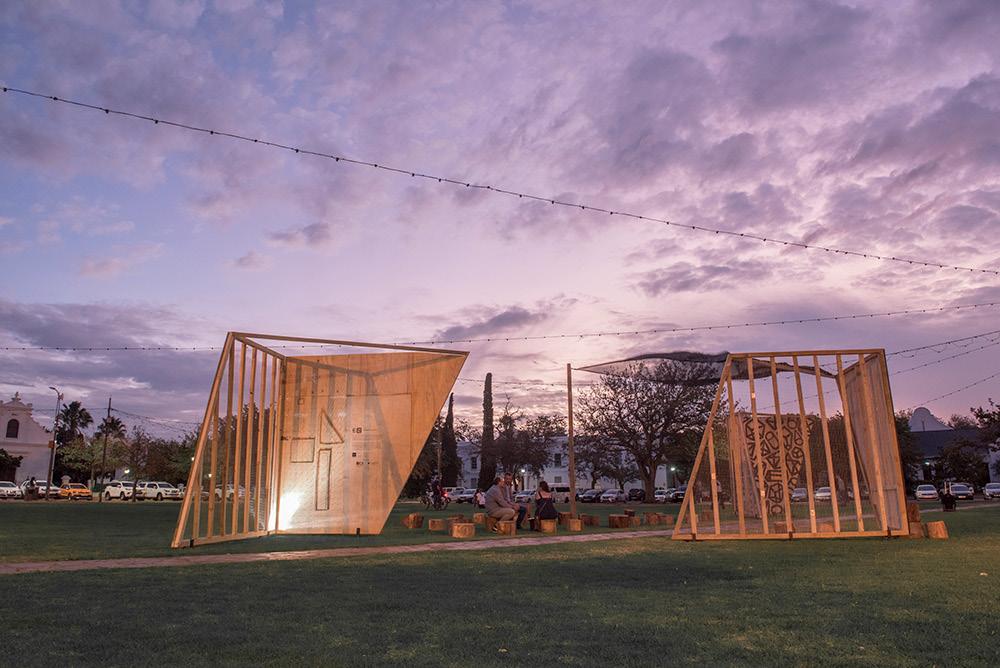
3 minute read
Space of waste
PHOTOGRAPHY ABRI KRUGER; PIETER MATHEWS
The last inaugural launch event at the Stellenbosch Triennale, an event originally planned to run from 11 February until 30 April 2020, but closed early as a result of the COVID-19 outbreak, was the launch of a pavilion on the Braak, Stellenbosch’s town square. Die Braak Pavilion, a temporary structure designed by architect Pieter Mathews, was designed to provide a platform for education, talks, information gathering and dialogue during the Triennale.
Die Braak is the heart of Stellenbosch, situated at a key point between historic churches, the university and magistrate’s court. Once a vital public space, in more recent times functioning as a starting point for guided tours of the town, it has of late fallen into dereliction and disrepair.

The armature of the pavilion defined its structure, encouraging the local population to participate in filling in its walls with materials such as discarded fishing nets, ropes, plastic bags and nylon packaging.
As well as catalysing the revitalisation of the square, aiming to reactivate the public space of Die Braak and shifting the local population’s relationship with shared space, the pavilion also included an ecological dimension.
The word ‘braak’ means fallow land, a description often used in post-apocalyptic art and movies, here reminding us that if we do not care for our planet, it eventually will become ‘braak’. Echoing the theme of the Triennale, Tomorrow There Will Be More Of Us, the intervention invited participants to ultimately determine the aesthetic of the Pavilion, just as our choices would determine the ‘tomorrow’ of our planet.
The notion of ‘embodied experience’, explained by architectural theorist Juhaani Pallasma as a full sensory experience in time and place, was the foundation of the pavilion. It was intended as a space to be experienced, to be interacted with and contributed to. The Pavilion as a fusion between the disciplines of public art, sculpture and architecture.
The pavilion was constructed of reclaimed materials for construction sites – shutter boards, scaffolding planks, hoarding nets – inviting conversations on the future of our environment and the notion of waste as a resource. As such, it was an analogy for a planet of waste, devoid of resources.
Rather than a finished object, the pavilion could be considered the ‘armature’ or skeleton intended to ‘grow’ throughout the Triennale as people participated in its making. By providing only the armature as defined structure, the Pavilion encouraged the local population to participate in the filling in of the Pavilion.
Its main axis was a pedestrian walkway frequented by a cross-section of Stellenbosch’s population, from students and magistrates to residents and homeless people. By inviting the participation of all sectors and stakeholders in the public life of Die Braak, the pavilion also aimed to become a meeting point and the beginning of a transformation in the nature of this central public space – from a polarising and divisive area to a safe and democratically inclusive space.
Waste materials such as discarded fishing nets, ropes, plastic bags and nylon packaging were woven and knotted as infill material. The reuse of waste material communicated the value of waste and the future of a waste economy. The Pavilion stood as a metaphor for the future of our planet’s depleting resources and the value of what we today refer to as waste. As people wove their own strands of waste into its structure, it became a metaphor for each person’s individual contribution to the conservation of the planet. The outcome does not depend on a select few, but rests on the collective shoulders of every human being.

The pavilion was constructed of reclaimed materials from construction sites such as shutter boards, scaffolding planks and hoarding nets.
An afterlife for the Pavilion is envisaged: as a playground for a crèche or perhaps a shading device for local crafters. Conversations around everyday materials and their afterlives are integral to the message the Pavilion portrays.

The main axis of the pavilion was a pedestrian walkway cutting through the Braak, a public space frequented by a broad cross-section of Stellenbosch’s population.
PROFESSIONAL TEAM ARCHITECT: Mathews and Associates Architects SPONSORS: CS Property Group; Cape Nature










